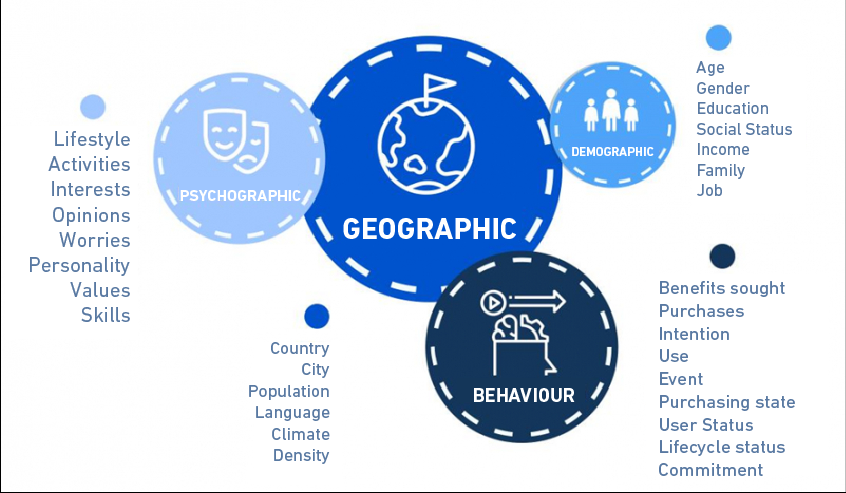 Glossary
Glossary
The importance of segmenting a market
To sell a product or service it’s not enough to just show it and sit and wait for people to come asking about it. You need to clearly outline what your target audience is, you need to know who to sell to, and who could be interested and how you’re going to reach them. This task becomes easier when you start segmenting in marketing.
Segmentation aims to split the market into groups with similar characteristics and needs. Therefore, the main goal of segment marketing is to adapt the company’s offer to the needs of these groups.
What to keep in mind in marketing segmentation?
Now that you know what segmenting is, you need to recognise the features to take into account in the market:
-Lifestyle and personality
-Where they live: city, country, post code
-What relationship they have with the Brand and how many times they’ve bought from it
-Gender, age, profession, education
The more thorough this segmentation in marketing is, the more we dig to the bottom of the market we want to reach, and then the more likely it will be that they buy your product or service. This information is very crucial when creating a buyer persona.
All brands target a different market, so it’s important to take into account everything that your brand includes. It would be a mistake to think that two clothing shops will target the same public just because they sell similar products. Everything is important: prices, styles, types of fabric, whether the clothes are young, formal, casual, trendy, or whatever other style.
Types of market segmenting
There is something really important here, and that is that we must be clear on the different approaches to segmentation. These are the types of segmentation in marketing:
–Mass Marketing: selling a product in the same way to the whole market.
–Segmentation Marketing: dividing each person according to their characteristics such as where they live, what their profession is, their lifestyle, frequency of purchase online. It’s like taking a magnifying glass to your consumers and breaking down their specific characteristics.
-Niche Marketing: narrows the segmentation focus even further, looking for smaller markets with needs that are not well met
–One-to-One Marketing: approaching each customer and treating them individually, as if you were only talking to them. Read more about digital marketing personalisation

Why is it important to segment?
The importance of segmentation in marketing lies in offering customers something that really interests them and satisfies their needs, because that’s the only way they come back and the only way for you to meet your business goal.
So, what happens when you don’t segment your market? If you don’t know who you are selling to or who you are going to offer your product to on the internet, your information may go unnoticed.
Think about it, putting a detergent on one of the shelves in a supermarket in the biscuit aisle is not the same as putting that detergent on the shelf where all the cleaning products are and making it stand out in some way.
In the first case, customers would probably end up ignoring the product because if they are in a biscuit aisle, that means they are looking for biscuits and not detergents. In the second case, your product is more likely to be selected because the people who see it are potential customers, people who are looking for exactly what you offer, what is in front of them.
The same thing goes for selling a product online. You need to make it visible for people that will be interested in it and, have the result that they end up buying the product.
How to segment in marketing?
The most important thing when segmenting is to know your product so well (after carrying out a study), that you can start to recognise what type of market you want to sell to, who you want your consumers to be, where they are in the world, what their passions are, what they look for when they surf the internet, etc.
Take every detail into account, however small it may seem, when deciding who to target. Even if you don’t think it’s relevant, when it comes to selling, it could cause problems if you don’t offer the product to those who are really interested in it.
After identifying these points, if you want a successful marketing campaign, you must start generating content for each of these segments.
You can have an audience that does not know your brand and you need to show them who you are and what you do. But also, you’ll have those who have already purchased your product and service which you’ll want to turn into loyal consumers of your brand. So, depending on what you want to achieve, you will create a type of message for each audience.
Common mistakes in marketing segmentation
Because market segmentation is a complex process, it’s normal to make mistakes. Here are some of the mistakes you should try to avoid as much as possible:
- Segmenting too much
- Segmenting with no strategy
- Not adapting new segments
- Focusing too much on demographics
- Creating too many segments
To conclude, segmentation in marketing is a key starting point to increasing your sales. Once you have this part down, the work will have to focus on developing a good marketing strategy to achieve a greater number of sales by reaching the right people.


